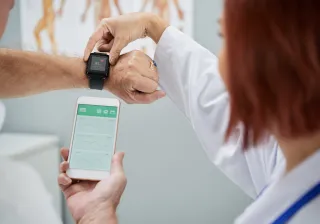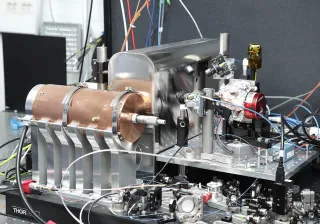Monitoring the body's fluid balance will soon be groundbreakingly easy. For this purpose, VTT's research project developed a meter that analyses sweat: a wearable bracelet.
Tracking one's own health and self-monitoring are a very strong trend. There have been various pulse meters and heart rate monitors on the market for a long time for both personal and medical purposes. Glucose meters have also been used for a long time to measure and monitor blood sugar levels.
The perspiration meter is a new – groundbreaking – addition for monitoring one's own well-being and personal diagnostics.
- We wanted to develop a meter to analyse fluid balance without the need to break the skin to obtain a sample. The technology of the meters is already highly advanced, so it is possible to implement this, says Jussi Hiltunen, D.Sc. (Tech.), Research Professor, Printed Intelligence at VTT.
Sensor indicates salt balance
The meter is a bracelet-type device with a fixed electronic part and a disposable, replaceable sensor. When activated, the sensor analyses salt balance from the sweat secreted on the skin. Salt balance can also be analysed by stimulating sweat secretion chemically.
Hiltunen says that a period of perspiration lasting a few minutes is normally enough to analyse sweat. With athletes, the measuring period is typically a few dozen minutes, and in endurance sports, such as long-distance running, the measurement is controlled to take place over several hours.
- This allows the constant monitoring of freshly secreted sweat, and for athletes, essential data is gained about, for example, what happens at which stage of the performance with regard to hydration, Hiltunen says.
Hiltunen points out that the perspiration meter is intended for consumers interested in their own well-being. It indicates if the body is getting dehydrated, but no medical health-related diagnoses can be made based on the meter.
- The disposable sensor can also be used to determine glucose and lactate concentrations. The meter we have developed can be an indicator in that regard, but we do not claim that it replaces traditional glucose meters.
- If, based on the analysis provided by our meter, you suspect that there are grounds for examination, then it is advisable to go to a doctor. In more serious situations, there are medical devices whose results are used to make health-related decisions, he says.
For athletes and others interested in their health
According to Hiltunen's estimate, the commercialisation of the perspiration meter will take a couple of years.
- The research programme for printed intelligence has been ongoing since the millennium. Electronics, diagnostics and optics have been developed to a great extent, and I believe that the cost of production can be brought down so that the purchase price of the device is suitable for consumers.
High-quality disposable sensors are manufactured by printing. They are launched on the market in rolls containing thousands of sensors.
According to Hiltunen, the most important user group is likely to be in sports where information is needed for hydration. Consumers with suspected problems with salt balance or dehydration can also use the meter to determine their condition.
Perspiration research has been conducted in many different projects for several years already. Some of the projects are internal to VTT and some are implemented in national or international cooperation between different operators.
Participants in this particular perspiration meter project include a research unit from the University of California, Berkeley and, in addition to Jussi Hiltunen, Senior Scientist Christina Liedert and Principal Scientist Ari Alastalo from VTT, among others. Liedert is strongly involved in developing a mass production method and Alastalo in implementing a reader for the meter.






